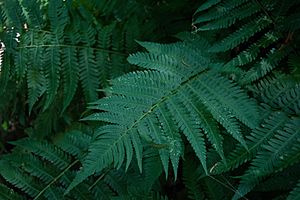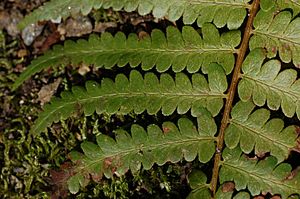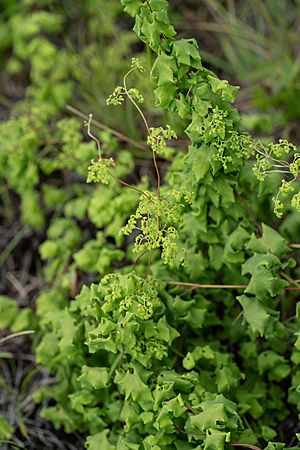List of ferns of Georgia (U.S. state) facts for kids
This is a list of ferns and other pteridophytes that naturally grow in the U.S. state of Georgia. Pteridophytes are a group of plants that reproduce using spores instead of seeds, like ferns, horsetails, and clubmosses. Georgia is home to many different kinds of these fascinating plants!


Contents
What are Ferns and Pteridophytes?
Ferns are ancient plants that have been around for millions of years. Unlike flowering plants, they don't produce flowers or seeds. Instead, they reproduce using tiny spores, which are like dust-like particles. Pteridophytes is a bigger group that includes ferns and other similar plants. They are an important part of Georgia's natural habitats, growing in many different places from mountains to coastal plains.
Common Ferns You Can Find
Georgia's diverse landscapes mean you can find many types of ferns. Some are very common and grow almost everywhere, while others are only found in specific areas.
- Christmas Fern (Polystichum acrostichoides): This fern is very common across Georgia, except in the southeastern pine flatwoods. It gets its name because its fronds (leaves) stay green all winter, even around Christmas!
- Resurrection Fern (Pleopeltis polypodioides): You can find this amazing fern all over Georgia. It's called "resurrection fern" because it can curl up and look dead when it's dry, but it quickly unfurls and turns green again when it rains. It often grows on tree trunks and rocks.
- Bracken Fern (Pteridium aquilinum): This fern is widespread in Georgia. However, it's important to know that it can be invasive and is poisonous if eaten. It's not a good idea to plant it in your garden.
- Cinnamon Fern (Osmunda cinnamomea): This fern is found throughout the state. It's easy to spot because it produces tall, cinnamon-colored spore stalks that look like cinnamon sticks.
- Sensitive Fern (Onoclea sensibilis): This fern is found across Georgia, though less often in the southeastern coastal plain. It's called "sensitive" because its fronds are very sensitive to frost and will die back quickly in cold weather.
Ferns with Special Stories
Some ferns in Georgia have unique features or interesting names.
- Carolina Mosquitofern (Azolla caroliniana): This tiny fern floats on water. It's interesting because a blue-green algae grows between its leaves, which helps it grow. While native, it can spread easily, so it's not usually recommended for planting in ponds or water features.
- Climbing Fern (Lygodium palmatum): Also known as Hartford fern, this fern is special because it actually climbs! It has limited populations in the northern part of Georgia.
- Rattlesnake Fern (Botrypus virginianus): Found mostly in northern Georgia, this fern has a unique look. Its fertile frond, which carries the spores, looks a bit like a rattlesnake's rattle.
Protecting Georgia's Ferns
Many ferns in Georgia are doing well, but some need our help to stay safe. Scientists use a system called NatureServe conservation status to describe how secure a plant species is.
- G5 - Secure: This means the plant is very common and widespread. Most of Georgia's ferns fall into this category, which is great news!
- G4 - Apparently Secure: These plants are still common, but there might be some concerns about their long-term future. Examples include the Log Fern (Dryopteris celsa) and the Southern Wood Fern (Dryopteris ludoviciana).
- G3 - Vulnerable: This means the plant is at a moderate risk of disappearing. In Georgia, the Alabama grapefern (Sceptridium jenmanii) is one example of a vulnerable fern. It's found in moist and dry forests, as well as disturbed areas. Protecting its habitat is important.
By learning about these amazing plants, we can help make sure they continue to thrive in Georgia for many years to come!



